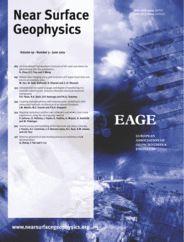
Full text loading...
 , Mark E. Everett1
, Mark E. Everett1 , Peter S.K. Knappett1
, Peter S.K. Knappett1
This paper underscores the importance of spatially dense geophysical data sets for making informed decisions in water management strategies. Such decisions may require understanding how site‐specific subsurface architecture – especially hydraulic connectivity – impacts the response of a shallow aquifer to anthropogenic hydrologic disturbances (e.g. over‐pumping of a shallow aquifer). At a 0.2‐km2 alluvial floodplain site characterized by thick clay over fine sand to gravel and shale bedrock in the subtropical, sub‐humid belt of the Gulf Coast of the United States, we image an asymmetrically shaped, compartmentalized, sand‐dominated channel‐belt using electrical resistivity tomography and 31 time‐domain electromagnetic soundings probing to depths of ∼40 m and ∼90 m, respectively. Lithological interpretation and a hydrological model are developed based on the geophysical data and nearby sediment cores, where the resistivity of the groundwater is 9.1 Ωm. In a modelling scenario wherein the compartmentalized sand channel‐belt starts out dry (i.e. an over‐pumped shallow aquifer), we simulate 26 weeks of infiltration due to flooding of the surface. Preferential filling of the channel‐belt occurs through its sides rather than from above, generating a new understanding of the hydraulic connectivity around and into asymmetrically shaped, sand‐dominated channel‐belts. This insight can inform decisions about the optimal placement of shallow water wells in a heterogeneous alluvial floodplain aquifer system and also highlights the dangers of over‐pumping.

Article metrics loading...

Full text loading...
References


Data & Media loading...

